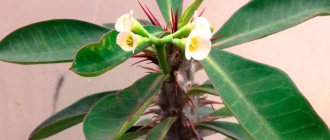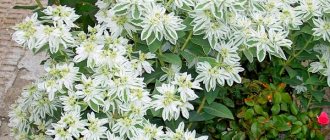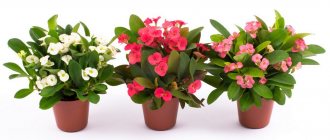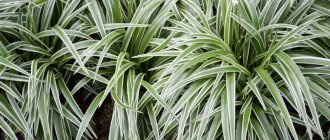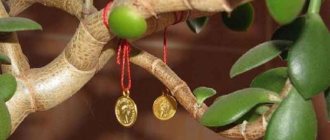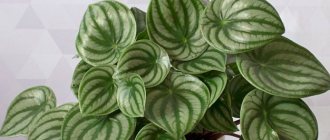Euphorbia as a houseplant is known to many under the name “Christmas star”, however, this is far from its only variety. You can grow this flower not only on the windowsill, but also in the garden. Moreover, among its huge species diversity, there are many plants that are unsuitable for planting and care at home due to their impressive size. The high decorativeness of the flower is successfully combined with its unpretentiousness in agricultural technology, however, it should be remembered that the plant is poisonous.
Description of milkweed with photo
The birthplace of culture is the African continent. Madagascar and Central America. The botanical name of the plant is euphorbia; it is the most basic and most numerous representative of the Euphorbiaceae family of the same name. It looks like grass, shrubs, and in rare cases, trees. The appearance of representatives of the genus can also be very diverse. With smooth, leafy or prickly shoots, cactus-shaped, columnar and others. A common property, like all euphorbias, is the presence of milky sap in all parts of the plant, which, like all members of the family, in its pure form is caustic and toxic. Herbaceous forms of milkweed can have either a one-year or perennial life cycle. The shoots are most often of an ascending type, up to strictly vertical, but there are creeping types (“jellyfish head”) and spherical ones, which do not give lateral branches at all.
The height of milkweed varieties varies within very significant limits, from a few centimeters in dwarf representatives to exceeding human height. During flowering, in the upper part of the shoots, the leaves turn into bright bracts, creating the impression of a smooth transition into a small but bright bouquet.
Euphorbia is a poisonous crop that is not recommended to be grown in areas where there may be accidental contact with children or pets.
Benefit
The culture is very common in folk medicine. Using parts of the plant, decoctions and tinctures are made , which are beneficial in the treatment of many diseases.
Euphorbia juice is a diaphoretic, diuretic, analgesic and anti-inflammatory agent.
Among them it is worth highlighting:
- Skin diseases : burns, ulcers, warts, lichen;
- Haemorrhoids;
- Constipation;
- Stomach diseases , including gastritis;
- Diseases of the genitourinary system , including cystitis;
- Tumor formations : benign and malignant;
- Colds ;
- Tuberculosis;
- Bronchial asthma;
- Female gynecological diseases .
Types of milkweed with names and photos
There are a huge number of varieties of milkweed; according to some sources, their number exceeds 2000. In Russia and the CIS countries alone, the culture is represented by 160 species. Most of them can be cultivated both at home and in the garden; we list the main popular types of garden and suitable for indoor growing of milkweed.
Euphorbia white-veined
Herbaceous perennial native to the island. Madagascar, producing shoots 1.5 meters high. At a young age it does not branch; at a more mature age it produces weak side shoots. The stem in the lower part is cylindrical, woody, in the upper part it has a pronounced five-rib section with traces of rough scars from fallen leaves. Grown as an indoor crop, the color is small and inconspicuous. It is characterized by rapid growth and a tendency to self-sowing.
Euphorbia ribbed
The second name of the species is comb. It is of Mexican origin and is very similar in appearance to the white-veined variety. The leaves are dark green, with pronounced veining. The trunk is ribbed, heavily spiked. The bracts are light pink.
Euphorbia brilliant (beautiful)
A very tall variety, reaching 2 m in height. The surface of the stem is cactus-shaped, lumpy, dark gray in color, with a large number of sharp cone-shaped spines. With age, the stem becomes bare from below, exposing 3-centimeter thorns. The bracts are brightly colored and can be scarlet, orange, beige, yellow or pink.
Euphorbia triangular
Inhabitant of desert regions in the southwest of the African continent. A tall species with shoots tightly pressed to each other, growing strictly vertically. The stems are strongly ribbed with three flat edges on which claw-shaped spines are concentrated. From the axillary buds grow spines and spade-shaped leaves, the length of which does not exceed 5 cm. Flowering of this variety is an extremely rare occurrence. Euphorbia triangular is propagated vegetatively using cuttings or rooted leaves.
This species has varieties in which the shoots are dark green and the foliage is red. They are very popular among gardeners due to the fact that, unlike flowering varieties, they remain decorative throughout the growing season.
Euphorbia beautiful (poinsettia)
This particular variety is called the “Christmas star”. It blooms with the onset of winter, blooming brightly in a rich scarlet color. It is a highly branched tall shrub and, at home, a small houseplant that bursts with bright color on Christmas Eve. In addition to this well-known one, there are many other varietal varieties of poiscentia, the bracts of which have a different color - orange, yellow, pink and others.
Euphorbia "jellyfish head"
The origin of the species is the southern tip of the African continent. It is a perennial with strongly branching shoots that grow horizontally and are prone to lodging. The appearance of this milkweed resembles a tangled ball of snakes. The shoots are fleshy, gray-green in color, with purple spots. The leaves are small, inconspicuous, narrowly belt-shaped. With age they remain only at the top. Unlike other species, the flowering of the “jellyfish head” does not have decorative value and is lost against the background of the spectacular appearance of its stems.
Euphorbia obese
Absolutely unlike other varieties, it has a thick spherical stem, more reminiscent of a cactus. At a young age, it has the shape of a perfect ball, then it stretches upward and resembles a baseball in outline. The stem is octagonal, about 30 cm, does not branch. It blooms in dense inflorescences that look like small green cones.
Euphorbia enopla
This species, even more than the previous one, has an external resemblance to a cactus. The cylindrical shoots are strongly branched along the entire length, have faintly pronounced ribs, planted with large curved spines. It can reach a height of 1 m. Flowers are formed in the apical part, the bracts are painted bright red.
Growing Euphorbia
Euphorbia alba is the most popular for growing at home. The trunk, thickened towards the top, consists of 4, 5 ribs, along the edges of which stipules are located.
The cuttings are reddish, the color of the foliage is emerald, the white veins are pronounced. Each fallen leaf leaves a mark on the trunk.
New leaves grow only at the top; an adult plant resembles a strange palm tree (see this euphorbia in the photo). It happens that in the fall the leaves fall, and in the spring new ones grow.
The flowers are inconspicuous (sessile inflorescences, without bright bracts, almost transparent petals). This species grows quickly even without care and reproduces independently.
The seeds germinate in potted plants located nearby. To plant new plants, you can also use the lateral shoots growing on the stem. If it is necessary to grow a lot of new white-veined euphorbia, the seeds are collected, lightly pressed into the soil, and covered with film.
Watering euphorbia
For irrigation, water at room temperature is used. Fertilizers produced for succulents are applied monthly. In winter, the plant is watered after the soil is completely dry; the temperature cannot be too low. The air of a city apartment is not a hindrance even in the absence of spraying.
The soil
The soil mixture is made from leaf humus, peat, sifted and washed sand in equal parts. The container is not deep, wide (the roots of this species are weak). If a large plant is being transplanted, pebbles are placed under the soil to ensure stability.
Temperature
Temperature in cold weather up to +15°C. In summer it is watered abundantly; regular spraying is advisable. For monthly feeding, cactus formulations are used.
Transfer
An annual transplant of Euphorbia Mil is not required. The soil consists of turf, preferably clay, humus, sifted sand, and leaf humus. For propagation, the bush is divided or cuttings are germinated. On new plants, the tips of the stems are pinched.
The triangular euphorbia flower is almost no different in appearance from a branched cactus. The triangular stem has straight spines, the foliage is oval and bright. In fertile soil this species grows very quickly. It is imperative to pinch the top of the head to limit height growth. The pot can be placed not only in the light, but also in partial shade.
During growth, abundant watering and monthly fertilizing are required. If this plant is not watered for several days, it will not die, it will only shed its foliage, which quickly grows back after watering. In winter, humidity is limited.
Also take a look at the article about Episcia.
How to propagate milkweed?
Propagation of milkweed is available in three ways.
Sowing seeds
In order to obtain milkweed seeds yourself, you must have at least one female and one male. In this case, the crop can propagate by self-seeding and makes it possible to collect suitable seed material. Sowing seeds is carried out in open ground; this can be done in winter or spring. Milkweed seeds have a rough shell and require scarification (physical destruction of the hard outer shell that prevents the embryo from germinating). To do this, the fruits are carefully ground with fine sandpaper in such a way as to destroy the upper shell, but not damage the embryonic kernel. To get early flowering in the open ground, milkweed seeds can be planted at home in a flower pot in the winter, and taken out into the garden in the spring with the onset of stable warmth.
Cuttings
Young shoots are used as cuttings, which are cut into pieces at least 10 cm long. For thick shoots, the sections need to be dried for 24 hours; you can sprinkle them with a root formation stimulator, and then place them in a moist substrate. To speed up rooting, the cuttings are covered with bags or transparent plastic containers. Rooting will take about a month, after which the cuttings are transplanted by transshipment to a permanent place.
Dividing the bush
This method is not suitable for all species, but only for well-branched varieties of milkweed. The algorithm of action is usual. The bush is dug out of the ground and divided into several sections, preserving several above-ground buds and part of the root system. Specimens not younger than three years of age must be divided.
In addition, many species of milkweed produce numerous shoots, which are excellent propagation material.
Features of euphorbia content
Most species love the sun; shade is required in hot weather. You shouldn’t be overzealous with watering; less is better than too much.
The exception is species with foliage, which require abundant watering in summer. Fertilizers are selected. Taking into account the characteristics of the species. The temperature during winter dormancy is not lower than +16°C.
For milkweeds, containers with a drainage layer and a hole in the bottom are selected. The soil mixture is the same for all types. Young plants must be replanted annually.
The main method of propagation is cuttings, for spherical species - seeds. Cuttings are harvested during spring pruning or summer. Be sure to immerse in water to get rid of excess juice. For rooting, a sand-peat mixture is used.
An important part of caring for euphorbia is the fight against fungus and insects. The main disease is fungal and manifests itself as rotting of the trunk and roots.
If the root system is damaged, the spurge is removed from the container, the roots are cut off, and the euphorbia is transplanted into another container with a new soil mixture. When the trunk rots, only the tip takes root.
If there is a whitish coating on the foliage (powdery mildew), the plant is treated with a fungicide. It is advisable to reduce watering and move the spurge to a more illuminated place.
A thin thread on the foliage indicates the appearance of a spider mite. The plant is sprayed with a soap solution; in case of severe damage, a systemic insecticide is required.
Euphorbias do not get sick if the rules of planting and care are followed:
- the substrate is too loose or too heavy;
- there is no good lighting, moderate watering, winter coolness;
- the root collar is covered with earth.
If spurge is constantly in contact with damp soil, the root collar becomes like a plug. It should be covered not with soil, but with gravel. Most species are succulents, so they store water. In summer, the soil can be completely dry for up to 3 days, in winter for more than a week.
During dormancy, additional lighting and watering are not required. When the room temperature is above +15°C, spurge grows. If there is not enough light, the stems become bent.
Planting milkweed
Before you begin planting or any other work with this plant, you must take safety measures in view of the toxicity of its milky sap. Euphorbia is distinguished by its low maintenance and ease of planting. If you plant it in open ground, you must choose an area open to sunlight or a slightly shaded area, with the exception of bordered milkweed. This variety prefers to grow in the shade, since bright sunlight is detrimental to the decorativeness of its foliage.
The plant does not tolerate excess moisture and acidity of the soil, so for planting it you need to choose a dry place, and acidified soils should be limed. The arrangement of high drainage, especially in places with clayey, poorly permeable soil, is mandatory.
external reference
- Media related to Euphorbia canariasis at Wikimedia Commons
- Decandall, A. (1837). "Illustration of Euphorbia canariasis
."
Plantarum historia succulentarum = History of grass plants
. Retrieved 2008-03-22.
| Taxon identifiers |
|
Euphorbia care
Growing in open ground does not require much trouble; the plant will be content with infrequent watering, even more infrequent feeding and timely weeding.
- Faded shoots must be removed as soon as possible to avoid self-seeding and loss of decorativeness of the flowerbed.
- It is necessary to water spurge not only moderately, but even sparingly, occasionally wetting the top layer of soil. With regular precipitation, this measure is not required.
- For feeding, universal mineral complexes for flowering plants are used.
- It is necessary to ensure that fertilizers applied during flowering contain a minimal amount of the nitrogen component or do not contain it at all.
